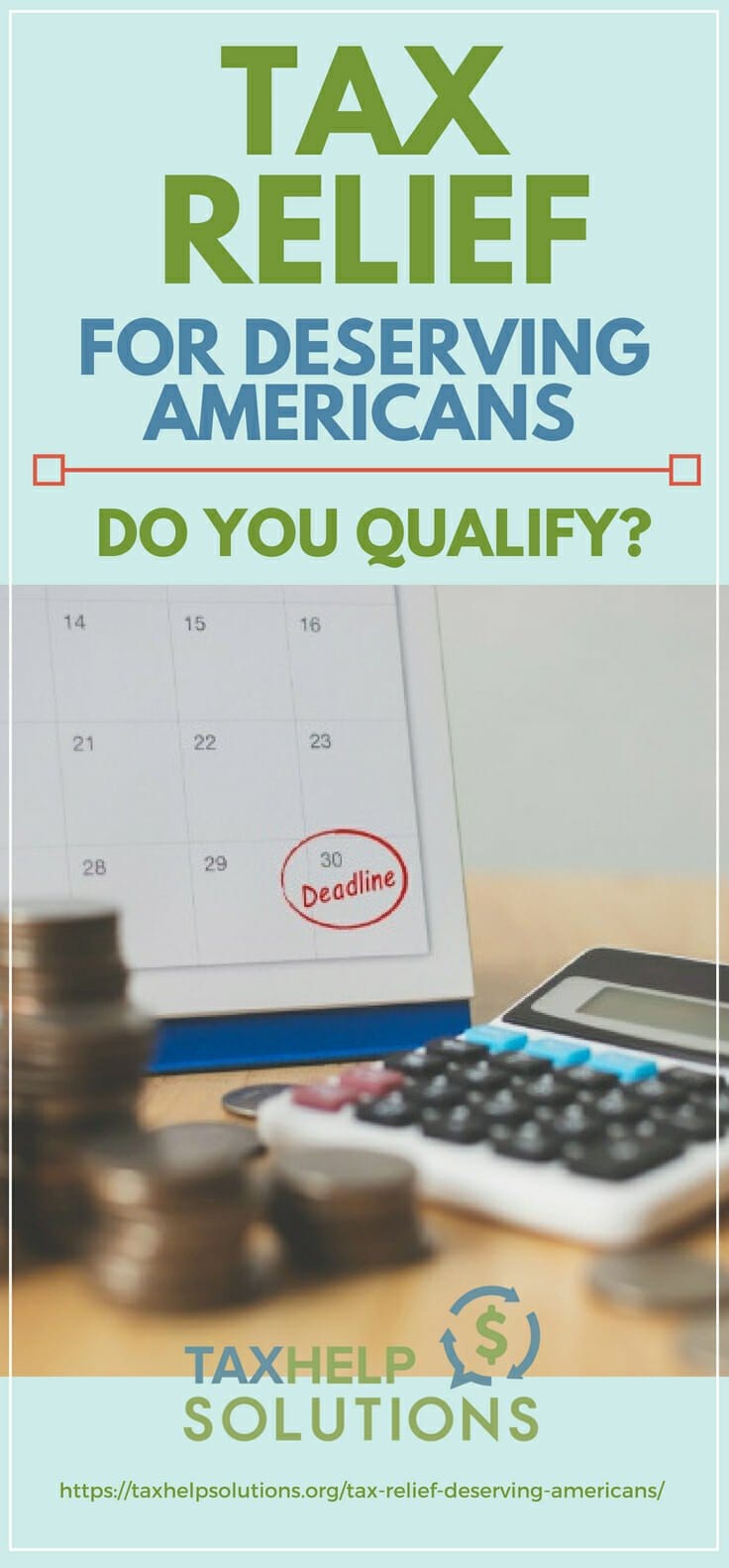For those who have a tax debt, these options for tax relief for deserving Americans are essential.
In this article:
Tax Relief for Deserving Americans | The Options and Qualifications
Work with the IRS
Anyone who has an income tax and files a tax return should know the choices for tax relief for deserving Americans.
The federal government, through the IRS, is going to make sure it will collect billions of dollars of tax revenues. It becomes a problem when the person owes them some money.
If a taxpayer has a tax liability, they may find themselves in constant fear of the IRS.
After all, under the tax law, the department can scrutinize their tax information. It can also conduct an investigation and an audit.
If there’s tax debt, it can attach a tax lien on the assets. It can affect the value of the real properties and credit history, among others.
What Is a Tax Lien? It is the government’s legal claim against a person’s assets. It happens when the individual becomes noncompliant in following tax regulations.
In some cases, the IRS may have to coordinate with the law enforcement if the agency suspects a criminal violation.
This fear may drive people to bury their heads in the sand and pretend the problem doesn’t exist. They hope it will go away.
In reality, this approach can cause more significant issues down the road.
The best option is to explore the various kinds of IRS tax relief programs. Taxpayers can also pursue other methods to reduce or avoid massive tax liability.
Get Help from Tax Professionals
The IRS isn’t as scary as it seems. If the taxpayer considers tax relief help, they may avoid interest fees and fines.
They may even be able to settle for less than they owe.
If the individual is nervous about dealing with the IRS, they may find it easier to handle negotiations with a third-party representative.
A tax resolution specialist can help people with back taxes and tax debts in the following ways:
- Assess the nature of the debt or back taxes, including the circumstances that might have contributed to the situation
- Create a personalized tax relief program
- Resolve the problem with the IRS on behalf of the taxpayer
Tax attorneys may be necessary during an audit or a criminal investigation.
No matter who helps, it’s possible to minimize the tax burden, but it’s essential one starts early.
Other IRS Tax Debt Relief Options
The following are other best choices for tax relief for deserving Americans:
1. Minimizing This Year’s Taxes
Tax relief usually focuses on resolving back taxes owed from previous years. Before it reaches such point, taxpayers must learn to keep the current tax burden to a minimum.
Small business owners and independent contractors, in particular, struggle to cover tax requirements. They can consider qualifying for a variety of generous deductions.
Medical expenses are often directly responsible for the Americans’ inability to pay taxes. Thankfully, they can deduct the same costs.
In 2017 and 2018, the IRS allows for deductions for qualified medical expenses that are beyond 7.5% of the adjusted gross income (AGI). By 2019, the deduction will cover allowable unreimbursed expenditures more than 10% of the AGI.
Besides covering preventative care and medical treatments, this deduction applies to travel expenses related to care. These include parking fees or bus fare.
Many working families struggle to cover taxes due to the high cost of raising children. The Child Tax Credit helps to offset and provide tax relief for deserving Americans.
The Tax Cuts and Jobs Act expanded this credit to $2,000 per qualifying child.
The family may also file a tax refund up to $1,400 for every child. The only requirement is the AGI is no more than $400,000 for joint filers or $200,000 for single people and heads of household.
To qualify, parents must claim the children as dependents. They should also provide care for at least six months of the tax year.
Needy families and children can also worry about the costs of higher education and student loan.
They can opt for education tax credits. They can choose between the American Opportunity Tax Credit (AOTC) and the Lifetime Learning Credit (LLC).
Another frequently overlooked option: the Credit for the Elderly or the Disabled. Designed for low-income seniors living off Social Security, this program provides a nonrefundable credit.
It won’t score the taxpayer a generous tax refund, but it can reduce the amount they owe. Depending on filing status, they can claim up to $7,500.
Claiming can be a hassle but is worth the effort, primarily if they work with a trusted third party.
RELATED: 9 Tax Relief Tips You Can Do When You’re In Tax Trouble
2. Installment Agreements
It’s vital for the taxpayer to express their willingness to settle their tax liabilities to the IRS. What happens, though, if they cannot afford to pay the debt all at once?
One of the options for tax relief for deserving Americans is an installment plan.
It allows them to spread the burden of paying thousands in back taxes over several months. These programs are widely available to American taxpayers.
Taxpayers may also qualify on the following types of installment agreements:
- Guaranteed
If the person owes no more than $10,000 to the IRS, they may be eligible for a guaranteed installment agreement. One requirement is the religious filing of tax returns with no late filing over the last five years.
Not only does it allow one to spread the payments, but they can also avoid a federal tax lien. They can repay their debt every month for up to 3 years as well.
- Streamlined
The streamlined installment agreement allows a taxpayer with a much higher tax debt to settle it with the IRS throughout 72 months on average.
In this option, the individual doesn’t need to fill out the Collection Information Statement. It is a document where they list down their assets, income, and expenses.
It also means the IRS doesn’t need to verify these details from the taxpayer.
The eligibility requirement can vary between individuals and businesses. This plan is for companies that owe no more than $25,000. The limit is higher for people at $100,000.
- Non-Streamlined
This may be an option for those who cannot qualify for the streamlined or the guaranteed installment agreement. It may result in a tax lien and may require negotiating with a tax agent, who will review the request.
On the other hand, it’s ideal for people with a high tax debt or those who like to extend their repayment plan beyond five years.
The installment agreement should make it easy for the taxpayers to pay the late fees, interest, and debt. Note, though, it demands close coordination with the IRS and commitment to follow through with the plan.
The IRS also needs honesty from the taxpayer. If they believe the person was not truthful with their tax information, the department can cancel the agreement.
An upfront approach is always preferable as well. One can save themselves a lot of grief by addressing the issue as soon as they become aware of the tax debt.
3. Offers in Compromise
What if the taxpayer cannot possibly resolve their tax problems through installments? It may be possible to permanently fix the tax debt without having to pay thousands in monthly installments.
A popular approach is an offer in compromise (OIC). It allows the taxpayer to settle their debt while paying less than they currently owe.
This option only becomes available after the taxpayers explored other methods. In most cases, the IRS can deny the request if it deems the person capable of paying in installments.
Other qualifiers include:
- No open proceedings for bankruptcy
- Filing of all federal tax returns
- Payment of the estimated taxes
- Submission of federal tax deposit if the person is either self-employed or has employees
Once the person qualifies for OIC, they may have to pay the amount as a lump sum or installments.
For a person to qualify for OIC, the amount must equal or exceed the reasonable collection potential (RCP). It refers to the amount the IRS can expect to gain from seizing the taxpayer’s assets.
The RCP takes potential future income into account.
If the taxpayer’s full assets are worth less than the required amount, OIC may be possible. It’s also likely if the individual may not earn significant income in the future.
Often, the IRS accepts OIC due to doubt of liability. It occurs if a dispute exists as to whether the taxpayer owes the debt.
If the reason for OIC is doubt of liability, the taxpayer can avoid paying an application fee. Overall, this IRS tax debt relief program can remove the tax lien and eliminate enforced collection.
4. Penalty and Interest Abatement
There’s no such thing as a perfect government agency, and the IRS is no exemption. It can commit mistakes in calculating the penalties and interests, which can increase tax liability.
In this instance, the taxpayer may apply for a penalty and interest abatement. It may also work if the individual can prove there is a reasonable cause to eliminate these from the tax debt.
A taxpayer can also take advantage of this tax relief for deserving Americans through the First-Time Abatement Program. To qualify, the person must have been consistent in settling tax dues for not less than three years.
Tax debts can ruin a person’s quality of life, but a tax relief for deserving Americans can prevent that. From installment plans to offers in compromise, options are aplenty.
The right tax credits and tax deductions can reduce the current tax burden. It can also decrease how much the person owes to the government.
With a little guidance and a proactive approach, one can put these tax issues in the past.
Did you experience using tax relief for deserving Americans? Tell us your story below.
Up Next: FAQs On Tax Debt Relief Act
Editor’s Note: This article was originally published on June 7, 2018, and has been updated for quality and relevancy.



